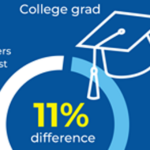
Adults could do much more to excite students about science as a subject and encourage their interest in science careers.
Science education reforms, like the Next Generation Science Standards and new curricula and assessments that go with them, are intended to improve student understanding of science and boost their interest in science careers. Unfortunately, many students think science is too hard, uninteresting, and irrelevant. Adults aren’t doing much to help students discover the fascination of science or point them toward science careers.
Two of our recent studies explored the development of secondary students’ science identities — their participation, perceived abilities, and aspirations in science. The findings illustrate how schools and families can hinder or support science interest and aspirations, and suggest ways to more successfully engage students in learning and appreciating science.
We engaged in two longitudinal studies to explore changes in aspirations, experiences, and attitudes in science over three years among students in California public middle and high schools. One study (Aschbacher, Ing, & Tsai, in preparation) surveyed an ethnically and economically diverse group of over 400 students who participated voluntarily in 7th through 9th grades; 48 students were later interviewed. The study identified four trajectories that students’ interest in science, engineering, and medical (S/E/M) careers took over time and described factors that affected their aspirations. The other study (Aschbacher, Li, & Roth, 2010) looked in depth at what happened to an equally diverse group of 33 10th graders who were very interested in a S/E/M career. It followed them through the 12th grade to discover what happened to their aspirations in high school.
Early interest
Most secondary students who were very interested in a S/E/M career during the studies said their interest began by age eight. It typically grew out of intrinsic interest, parent expectations, and/or fortuitous experiences such as time outdoors in nature, visits to museums and zoos, experiences with animals or building things, and exposure to television, movies, and the Internet. Elementary school played only a minor role since students said little science was taught in K-6. It was quite rare for students to initiate strong S/E/M interest after 7th grade. Only 4% of middle schoolers and none of the high school students studied did so.
Very leaky pipeline
Most students recalled liking science in childhood, but their interest subsequently declined. A third of the middle school students once very interested in S/E/M careers lost those aspirations by 9th grade; nearly half of the 10th graders, despite being capable and diligent, lost their aspirations by 12th grade. Overall, two-thirds of these secondary students with once-strong S/E/M interests dropped out of the pipeline during the study period.
Limited career information
Except for the most committed, high school students in both studies had very little knowledge of S/E/M career options and how to prepare for them. Many students said such career preparation wasn’t discussed in schools, families, or with friends. A few students had fairly firm and consistent career goals, but most had tentative and fluid aspirations, reflecting both momentary and cumulative perceptions of how much they enjoyed learning science and saw a S/E/M career as feasible and desirable — “a good fit” with their self-image.
Students’ science identities, participation, and goals were influenced by their science-related experiences and expectations at home, in school, and outside of school.
Is science me?
From both studies, we learned that students’ science identities, participation, and goals were influenced by their science-related experiences and expectations at home, in school, and outside of school. Students experienced different “microclimates” of science courses, teaching, counseling, peer attitudes, access to real scientists and their work, and family support for science. These, in turn, provided different resources, challenges, and opportunities, as well as expectations, feedback, and advice from key adults — all of which framed students’ perceptions of science, their abilities, career options, and chance to succeed. In the process, these perceptions influenced how students consciously or subconsciously considered the questions: What is science? How does it fit into my life? Am I good at it? Is science me?
Confidence in learning
The strongest predictor of students’ S/E/M career interests in grades 7 to 9 and their aspiration trajectory over time were the questions about confidence as a science learner. Interviews revealed how it was influenced by experiences in science class, extracurricular activities, and family settings. For example, when we asked Alison about experiences that made her feel she could be a scientist, she recalled winning a chance to attend a summer “astro camp.” She enjoyed it very much, especially the authentic activities. “We could do things just like scientists do, so I kind of thought I could do it, too . . . . I wish every student could go, because it makes you want to learn more about it.” This powerful opportunity allowed Alison to see what real scientists do, try her hand at it, and realize that she could do it. In turn she wanted to learn more. Unfortunately, such opportunities were rare: Among the high school students, only the most S/E/M-committed students had such experiences.
School science is “science”
From middle school on, opportunities for science-related activities outside school dwindled, so school science became the primary influence on most students’ perception of “science” — its value and purpose and their interest, capacity, and chance of success. In fact, student perceptions of school science predicted S/E/M aspirations in grades 7 to 9. In both studies, students most frustrated by school science experiences tended to lose interest in S/E/M careers. They said they liked and wanted to understand science, but as it became increasingly difficult, they began to disengage. Some said their teachers focused more on covering required topics than on student understanding and made them afraid to ask questions. After middle school, even some students with strong S/E/M interests were uncertain about continuing to study science. They predicted their 9th-grade experiences would be a deciding factor, and they were right: Those who reported more negative experiences in 9th-grade science class tended to lose interest in S/E/M careers.
School science became the primary influence on most students’ perception of “science.”
Students emphasized the teacher’s role, wanting teachers to be enthusiastic and fair, manage the classroom well so as to maximize time to learn, and use engaging instructional strategies to facilitate comprehension. They particularly valued hands-on labs, demonstrations, field trips, and teachers’ science expertise because that helped them comprehend complex ideas, see the relevance, and feel inspired to work at learning. Alison appreciated her science teacher’s encouraging comments that “we can be anything we want,” which made a “big difference” to her since she had feared that “being a scientist sounded too hard and complicated.”
Family influence
The stronger a family’s support for a child’s learning science, the higher the student’s confidence. Students said that after childhood most of their parents did little to support their S/E/M interests or aspirations. Instead, parents offered generic expectations “to get good grades and go to college” and “to do what I like and be happy.” Even parents in S/E/M jobs didn’t necessarily share their career knowledge or encourage S/E/M study. Some parents discouraged S/E/M interests in various ways, such as advising their children to avoid “hard” subjects like math and science. This undermined students’ confidence as they inferred parents believed they lacked the capacity to succeed. Other parents promoted activities like sports or the arts, leaving little time or reinforcement for S/E/M activities. In contrast, high-achieving high school students with strong S/E/M aspirations tended to have families that supported learning science, helped them cope with frustrations in school science, facilitated extracurricular science experiences, and provided role models and guidance for majors and careers.
Lost interest in S/E/M careers
A particularly interesting group to emerge in each study is one we termed the “Lost Potentials.” These students showed “potential” for a S/E/M career by initially saying they were “very interested” in one or more, but during the study period they lost interest. Lost Potentials were slightly more likely than those with consistently strong S/E/M interest to be female, from lower-income families, and Hispanic. What happened to them? They reported less enjoyable school science classes and less support for S/E/M interests from teachers and parents, and were slightly more uncertain about college, majors, and careers. With fewer extracurricular science experiences and limited home support to counter negative school experiences, Lost Potentials were at a disadvantage. Marta expressed the frustration typical for this group as she compared two science classes.
Miss L [6th-grade teacher] would tell it in a funny way, like in a way that we would understand it. Like if it was a big word, she would put it into words that we would understand, and she was really a cool teacher. [But this year in 7th grade] it’s not a lot of fun anymore. [My teacher] just tells us what to do and just sits there and we have to do it, but she doesn’t explain it or talk to us about it like Miss L, [who] would go through all the sections and stuff. Not Miss K . . . If she would just talk to us and help us with our work . . . But I’m scared to go ask her a question because she’ll just say, ‘Look it up!’
With fewer resources, Lost Potentials had limited perspective on science and S/E/M careers, so negative school science experiences more readily undermined both their confidence and aspirations. When they had trouble with a particular topic, course, or teacher, they were more likely to blame themselves, conclude they lacked the capacity to do science courses or jobs, and believe S/E/M jobs would be as tedious or difficult as the class. Students with more experience and confidence showed more resilience, e.g., reasoning that a bad experience in biology did not mean chemistry would be bad, too. Eighth graders who lacked confidence in their science abilities were afraid to take a “hard” science course next year and felt daunted by the prospect of long years of schooling to “succeed in science.” With little parental support, it was difficult for them to persist with S/E/M ambitions. “It’s kinda hard. They don’t put me down but they already have it in their minds that I won’t be able to go into NASA, my dream job, or go to a top college,” Marta explained.
Despite fewer opportunities to practice learning/doing science, Lost Potentials’ views of science and scientists continued to be positive, suggesting that their declining S/E/M ambitions didn’t reflect a dislike of science but rather a decreasing sense that “science is me.”
Teachers and parents play critical roles in helping students develop aspirations as they provide or block access to S/E/M learning activities and professionals.
Powerful adults, few advocates
Teachers and parents play critical roles in helping students develop confidence and aspirations as they provide or block access to S/E/M learning activities and professionals. They also react to and value student aspirations and experiences positively or negatively in light of their own knowledge, experience, and biases. They judge student abilities and chances for success, and they express value and encouragement or discouragement about student choices. They also provide (or fail to provide) information, guidance, reinforcement, and role models related to learning and doing science, and, in some cases, they promote competing activities and goals, making it more difficult to pursue S/E/M interests. Overall, student stories revealed that few had encountered adults who were strong advocates for studying science.
Implications for policy and practice
More than luck. Our research indicates the current system for inviting and preparing young people to learn science/engineering/medicine is passive and frail. Few adults actively encourage students to learn science and consider S/E/M careers. Instead, the “system” relies largely on luck: whether students happen to be intrinsically interested in science early and strongly enough to withstand later assaults on or distractions from this interest, whether they have parents who support S/E/M interest, and whether they encounter engaging topics, meaningful learning experiences, and teachers or mentors who help them develop confidence in learning science.
Informed, proactive adults. Our research illustrates how students continuously develop their identities as they participate in formal and informal daily activities at home, in school, and outside of school. Not only their content knowledge but also their sense of who they are and want to become emerges from the constraints and affordances of those experiences. Teachers and family members, in particular, are key socializers who, in daily interactions, not only convey their knowledge and beliefs about science and students’ abilities but also shape students’ access, interpretation, and evaluation of their experiences. Thus, educators, family members and others need to become informed about the personal and professional value of S/E/M learning and careers, effective S/E/M learning experiences, and the pathways to attain them. If science education reforms are to achieve broader science literacy and effective preparation for work and life, more than just the standards, curricula, and assessments must change. The broad community of adults who can influence young people’s lives and their science identities needs to change in ways that they become more aware of these goals and can proactively facilitate them. Beyond parents and teachers, this community includes education policy makers at all levels, district and school administrators, counselors, curriculum developers, teacher preparation and development professionals, foundations and government agencies that fund S/E/M programs and the people who run the programs, businesses and local government offices employing people with S/E/M training, colleges and universities, community service organizations, youth organizations, and youth-oriented media and product developers.
Improving school science. Our studies made clear that the elementary years are ripe for more rigorous, compelling school science experiences, and that secondary school experiences play a significant role in whether students want to learn science or will be prepared for S/E/M-related jobs. Students, like reformers (NRC, 2007), pointed to several avenues to improve school science, extracurricular activities, and teacher professional development, including:
- More equitable views by educators of who can and should learn science and why;
- Deeper teacher understanding of content and scientific practices for better instruction;
- More effective ways to scaffold new vocabulary and ways of thinking;
- More active and meaningful learning strategies and authentic investigations, compelling topics and engaging discussions about the meaning and relevance of ideas studied; and
- Prioritizing student comprehension of important ideas rather than merely covering the curriculum.
Teachers and others also should help students learn about the vast array of occupations that entail some S/E/M knowledge and how to combine interests or connect science to other fields. Students know too little about their options, like the boy who did not know he could combine his passions for graphic arts and science, or the students who were “very interested” in engineering but knew little about what it entails. Improved school science and extracurricular activities would offer more spaces where student learning and authoring of science identities could occur.
Our results also suggest students could benefit if schools helped parents be more supportive of S/E/M aspirations. For example, schools could substantively involve them in science projects and inform them of relevant school policies, such as those limiting access to college-track science or math courses and subsequent college and career choices.
Developing confidence. Our studies highlight confidence in one’s ability to learn science as key to student aspirations, but it is not yet a priority for many parents and educators. Many students said they really wanted to learn science in secondary school, but as it became increasingly complex they struggled to keep up and became less engaged, their confidence in their science abilities fell, and they questioned their S/E/M ambitions. Many encountered parents, teachers, or counselors who advised them to avoid science because “it’s too hard.” Whether from their own fear of science and math or a desire to spare the student a discouraging experience, this advice undermined students’ confidence and pursuit of S/E/M goals. If we really want all students to learn some science, then we need to provide encouragement and learning experiences in which they all can learn essential ideas. Advanced courses should still be available for students who need or want them.
Extracurricular opportunities. One thing that set apart the high school students who persisted in high S/E/M aspirations from those who lowered their expectations or dropped out of the pipeline was the chance to do compelling, authentic S/E/M activities outside of school. Internships, volunteer experiences in science labs, summer science camps, career workshops, and other special opportunities gave these students knowledge of science and scientists, confidence in their abilities, and inspiration about possible careers that would be meaningful and rewarding. Multiple experiences and sources of support over time helped nurture students’ interests and aspirations as well as counter negative experiences and self-doubt. Relatively few students have such extracurricular opportunities, but many more could benefit from expansion of existing programs supported by colleges, community organizations, and S/E/M businesses, perhaps partnering with local schools. Research scientists funded by the National Science Foundation are expected to do some educational outreach, making K-12 partnerships with them mutually beneficial. Perhaps the National Institutes of Health should consider broadening their policy as well. Involvement of local S/E/M businesses in special experiences for students, teachers, and parents can pay off by helping recruit and prepare students who may be their future employees.
Both individuals and society can benefit from greater science literacy, and more students might be interested in learning some science if learning opportunities were more personally relevant and provided more space to explore and develop who they might want to be.
References
Aschbacher, P.R., Ing, M., & Tsai, S.M. (in preparation). Is science me? Development of middle school students’ science aspirations.
Aschbacher, P.R., Li, E., & Roth, E.J. (2010). Is science me? High school students’ identities, participation, and aspirations in science, engineering, and medicine. Journal of Research in Science Teaching, 47 (5), 564-582.
National Research Council. (2007). Taking science to school: Learning and teaching science in grades K-8. Washington, DC: National Academies Press.
Acknowledgements
This material is based upon work supported by the National Science Foundation under Grant No. 0231878 and a grant by the S.D. Bechtel, Jr., Foundation. Any opinions, findings, and conclusions or recommendations expressed in this material are those of the authors and do not necessarily reflect the views of the National Science Foundation or the S.D. Bechtel, Jr., Foundation.
Citation: Aschbacher, P.R., Ing, M., & Tsai, S.M. (2013). Boosting student interest in science. Phi Delta Kappan, 95 (2), 47-51.
ABOUT THE AUTHORS

Marsha Ing
MARSHA ING is an assistant professor of education at University of California, Riverside.

Pamela R. Aschbacher
PAMELA R. ASCHBACHER is a director at California Institute of Technology, Pasadena, Calif.

Sherry M. Tsai
SHERRY M. TSAI is assistant faculty at the Oak Crest Institute of Science, Pasadena, Calif.










